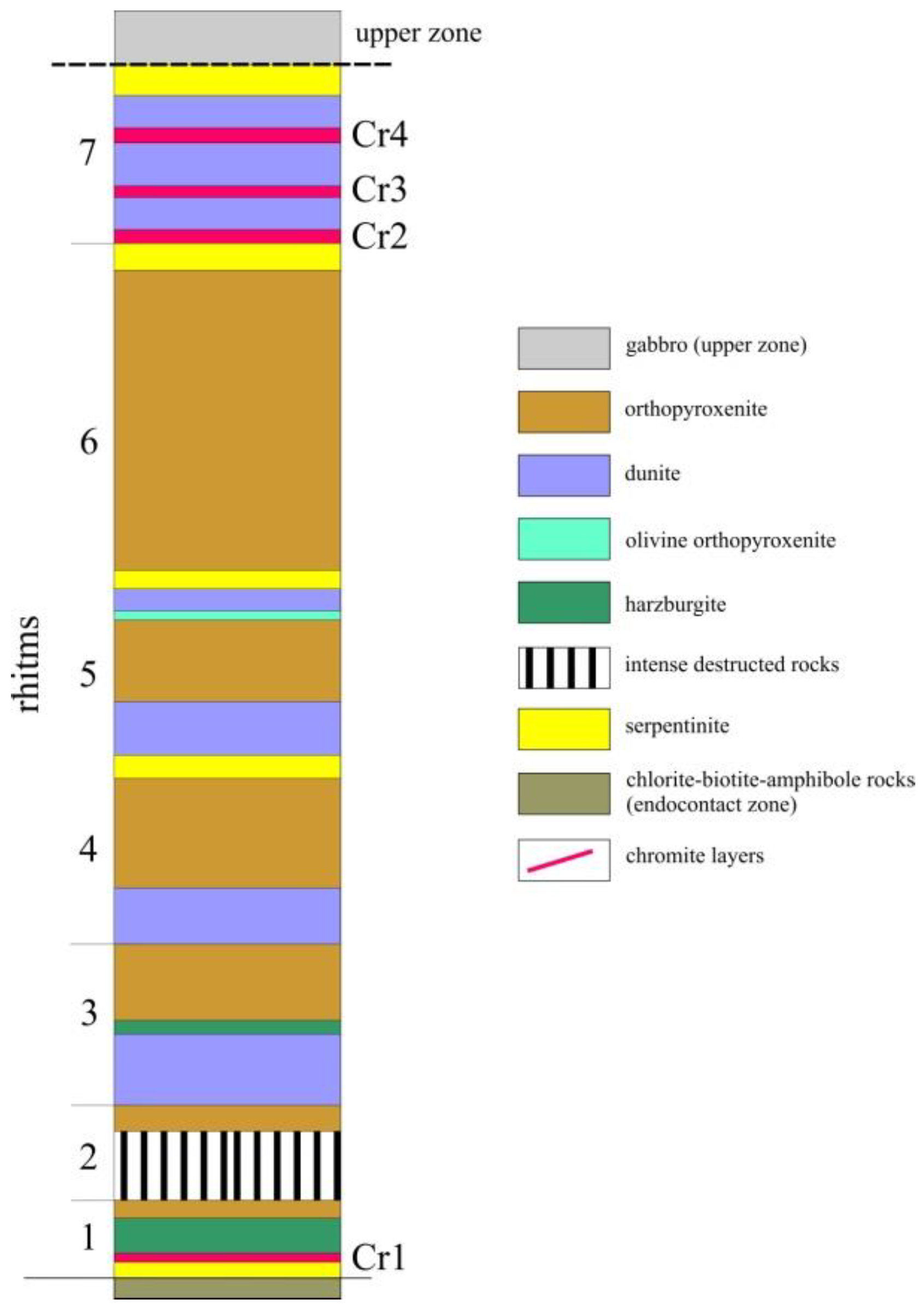Metallogenic Setting and Evolution of the Pados-Tundra Cr-Bearing Ultramafic Complex, Kola Peninsula: Evidence from Sm–Nd and U–Pb Isotopes
Abstract
1. Introduction
2. Geological Settings
2.1. Regional Geology
2.2. The Pados-Tundra Complex
2.3. Chromite Ore Bodies
3. Samples and Analytical Methods
3.1. Samples
3.2. Description of Geochronological Samples
3.3. Sm–Nd Method
3.4. U–Pb Method
4. Results
4.1. Dating of the Complex
4.2. Dating the Hornblende Dykes
5. Discussion
6. Conclusions
- (i)
- the emplacement of the layered Cr-bearing intrusion occurred at 2485 ± 77 Ma–2475 ± 38 Ma;
- (ii)
- horblendite dykes were intrusive at 2075 ± 59 Ma, which can be related to the origination of the Lapland–Kola Ocean;
- (iii)
Author Contributions
Funding
Acknowledgments
Conflicts of Interest
References
- Karykowski, B.T.; Maier, W.D.; Groshev, N.Y.; Barnes, S.-J.; Pripachkin, P.V.; McDonald, I.; Savard, D. Critical controls on the formation of contact-style PGE-Ni-Cu mineralization: Evidence from the Paleoproterozoic Monchegorsk Complex, Kola region, Russia. Econ. Geol. 2018, 113, 911–935. [Google Scholar] [CrossRef]
- Maier, W.D.; Hanski, E.J. Layered mafic-ultramafic intrusions of Fennoscandia: Europe’s treasure chest of magmatic metal deposits. Elements 2017, 13, 415–420. [Google Scholar] [CrossRef]
- Nerovich, L.I.; Bayanova, T.B.; Serov, P.A.; Elizarov, D.V. Magmatic sources of dikes and veins in the Moncha Tundra Massif, Baltic Shield: Isotopic-geochronologic and geochemical evidence. Geochem. Int. 2014, 52, 548–566. [Google Scholar] [CrossRef]
- Sharkov, E.V.; Chistyakov, A.V. Geological and petrological aspects of Ni-Cu-PGE mineralization in the Early Paleoproterozoic Monchegorsk layered mafic-ultramafic complex, Kola Peninsula. Geol. Ore Depos. 2014, 56, 147–168. [Google Scholar] [CrossRef]
- Yang, S.H.; Hanski, E.; Li, C.; Maier, W.D.; Huhma, H.; Mokrushin, A.V.; Latypov, R.; Lahaye, Y.; O’Brien, H.; Qu, W.-J. Mantle source of the 2.44–2.50-Ga mantle plume-related magmatism in the Fennoscandian Shield: Evidence from Os, Nd and Sr isotope compositions of the Monchepluton and Kemi intrusions. Miner. Depos. 2016, 51, 1055–1073. [Google Scholar] [CrossRef]
- Hanski, E.; Huhma, H.; Smolkin, V.F.; Vaasjoki, M. The age of the ferropicritic volcanics and comagmatic Ni-bearing intrusions at Pechenga, Kola Peninsula, USSR. Bull. Geol. Soc. Finl. 1990, 62, 123–133. [Google Scholar] [CrossRef]
- Sharkov, E.V.; Smolkin, V.F. The Early Proterozoic Pechenga-Varzuga Belt: A case history of Precambrian back-arc spreading. Precambrian Res. 1997, 82, 133–151. [Google Scholar] [CrossRef]
- Walker, R.J.; Morgan, J.W.; Hanski, E.J.; Smolkin, V.F. Re-Os systematics of early Proterozoic ferropicrites, Pechenga complex, NW Russia: Evidence for ancient 187Os-enriched plumes. Geochim. Cosmochim. Acta 1997, 61, 3145–3160. [Google Scholar] [CrossRef]
- Neradovsky, Y.N.; Alekseeva, S.A.; Chernousenko, E.V. Mineralogy and process properties of Kolvitsky titanomagnetite ore. In IOP Conference Series: Earth and Environmental Science; IOP Publishing: Bristol, UK, 2019; Volume 262, p. 012050. [Google Scholar]
- Voitekhovskii, Y.L.; Neradovskii, Y.N.; Grishin, N.N.; Rakitina, E.Y.; Kasikov, A.G. The Kolvitskoe deposit (geology, material composition of ores). Vestnik MGTU 2014, 17, 271–278. [Google Scholar]
- Baynova, T.; Ludden, J.; Mitrovanov, F. Timing and duration of Paleoproterozoic ore-bearing layered intrusions of the Baltic Shield: Metallogenic, petrological and geodynamic implications. In Paleoproterozoic Supercontinents and Global Evolution; Reddy, S.M., Mazumder, R., Evans, D.A., Collins, A.S., Eds.; Geological Society of London: London, UK, 2009; Volume 323, pp. 165–198. [Google Scholar]
- Mitrofanov, F.P.; Bayanova, T.B.; Ludden, J.N.; Korchagin, A.U.; Chashchin, V.V.; Nerovich, L.I.; Serov, P.A.; Mitrofanov, A.F.; Zhirov, D.V. Origin and Exploration of the Kola PGE-bearing Province: New Constraints from Geochronology. In Ore Deposits: Origin, Exploration, and Exploitation; Geophysical Monograph Series; Sophie Decree, S., Robb, L., Eds.; Wiley: Hoboken, NJ, USA, 2019; pp. 3–36. [Google Scholar] [CrossRef]
- Mitrofanov, F.; Golubev, A. Russian Fennoscandian metallogeny. In Abstracts of the 33 IGC; Norwegian Academy of Science and Letters: Oslo, Norway, 2008. [Google Scholar]
- Schissel, D.; Tsvetkov, A.A.; Mitrofanov, F.P.; Korchagin, A.U. Basal Platinum-Group Element Mineralization in the Fedorov Pansky Layered Mafic Intrusion, Kola Peninsula, Russia. Econ. Geol. 2002, 97, 1657–1677. [Google Scholar] [CrossRef]
- Amelin, Y.V.; Heaman, L.M.; Semenov, V.S. U–Pb geochronology of layered mafic intrusions in the eastern Baltic Shield: Implications for the timing and duration of Paleoproterozoic continental rifting. Precambrian Res. 1995, 75, 31–46. [Google Scholar] [CrossRef]
- Huhma, H.; Clift, R.A.; Perttunen, V.; Sakko, M. Sm–Nd and Pb isotopic study of mafic rocks associated with early Proterozoic continental rifting: The Perapohja schist belt in northern Finland. Contrib. Mineral. Petrol. 1990, 104, 369–379. [Google Scholar] [CrossRef]
- Halkoaho, T.; Alapieti, T.T.; Lahtinen, J.J. The Sompujarvi PGE mineralization in the Penikat layered intrusion. In Proceedings of the 5th International Platinum Symposium: Guide to the Post-Symposium Field Trip, Helsinki, Finland, 4–11 August 1989; Volume 29, pp. 71–92. [Google Scholar]
- Halkoaho, T.A.A.; Alapieti, T.T.; Lahtinen, J.J. The Sompujarvi PGE Reef in the Penikat layered intrusion, Northern Finland. Miner. Petrol 1990, 42, 39–55. [Google Scholar] [CrossRef]
- Hanski, E.; Walker, R.J.; Huhma, H.; Suominen, I. The Os and Nd isotopic systematics of c. 2.44 Ga Akanvaara and Koitelainen mafic layered intrusions in northern Finland. Precambrian Res. 2001, 109, 73–102. [Google Scholar] [CrossRef]
- Iljina, M.; Maier, W.D.; Karinen, T. PGE-(Cu-Ni) deposits of the Tornio-Näränkävaara belt of intrusions (Portimo, Penikat and Koillismaa). In Mineral Deposits of Finland; Maier, W.D., Lahtinen, R., O’Brien, H., Eds.; Elsevier: Amsterdam, The Netherlands, 2015; pp. 133–164. [Google Scholar]
- Balashov, Y.A.; Bayanova, T.B.; Mitrofanov, F.P. Isotope data on the age and genesis of layered basic-ultrabasic intrusions in the Kola Peninsula and northern Karelia, northeastern Baltic Shield. Precambrian Res. 1993, 64, 197–205. [Google Scholar] [CrossRef]
- Bayanova, T.B. Age of Reference Geological Complexes of the Kola Region and the Duration of Igneous Processes; Nauka: Saint Petersburg, Russia, 2004; p. 174. (In Russian) [Google Scholar]
- Bayanova, T.B. Baddeleyite: A promising geochronometer for alkaline and basic magmatism. Petrology 2006, 14, 187–200. [Google Scholar] [CrossRef]
- Huber, M.; Halas, S.; Serov, P.A.; Ekimova, N.A.; Bayanova, T.B. Sm–Nd dating and stable isotope geochemistry of sulfides and U–Pb ages of layered intrusions from the northern part of the Baltic Shield. Mineralogia 2012, 39, 107–108. [Google Scholar]
- Huhma, H.; Mutanen, N.; Hanski, E. Sm–Nd isotopic evidence for contrasting sources of the prolonged Paleoproterozoic mafic-ultramafic magmatism in Central Finnish Lapland. In Proceedings of the IGCP Project 336 Symposium, Rovaniemi, Finland, 21–23 August 1996; Volume 33, pp. 57–58. [Google Scholar]
- Mitrofanov, F.P.; Balagansky, V.V.; Balashov, Y.A.; Gannibal, L.F.; Dokuchaeva, V.S.; Nerovich, L.I.; Radchenko, M.K.; Ryungenen, G.I. U–Pb age for gabbro-anorthosite of the Kola Peninsula. Dokl. Earth Sci 1993, 331, 95–98. [Google Scholar]
- Peltonen, P.; Brugmann, G. Origin of layered continental mantle (Karelian craton, Finland): Geochemical and Re-Os isotope constraints. Lithos 2006, 89, 405–423. [Google Scholar] [CrossRef]
- Puchtel, I.S.; Brugmann, G.E.; Hofmann, A.W.; Kulikov, V.S.; Kulikova, V.V. Os isotope systematics of komatiitic basalts from the Vetreny belt, Baltic Shield: Evidence for a chondritic source of the 2.45 Ga plume. Contrib. Mineral. Petrol. 2001, 140, 588–599. [Google Scholar] [CrossRef]
- Serov, P. Comparison between Sm–Nd Rock-Forming Mineral and U–Pb Zircon and Baddeleyite Data of the Fedorovo-Pansky Pt-bearing Layered Intrusion; European Geosciences Union: Vienna, Austria, 2007; EGU2007-A-01156. [Google Scholar]
- Serov, P. New Sm–Nd isotope-geochemical data for the Fedorovo-Pansky PGE-bearing layered intrusion (N-E Fennoscandian Shield). In Geophysical Research Abstracts; European Geosciences Union: Vienna, Austria, 2012; EGU2010-8143. [Google Scholar]
- Serov, P.; Bayanova, T. Palaeoproterozoic Fedorovo-Pansky PGE-bearing layered intrusion of the N-E Baltic Shield: New isotope data. In 33 IGC; Norwegian Academy of Science and Letters: Oslo, Norway, 2008. [Google Scholar]
- Serov, P.; Ekimova, N.; Bayanova, T. Isotope-geochemical Nd–Sr evidence of Palaeoproterozoic plume magmatism in Fennoscandia and mantle-crust interaction on stages of layered intrusions formation. In Geophysical Research Abstracts; European Geosciences Union: Vienna, Austria, 2012; Volume 14, EGU2012-9113. [Google Scholar]
- Serov, P.A.; Ekimova, N.A.; Bayanova, T.B.; Mitrofanov, F.P. Sulfide minerals as new geochronometers during Sm–Nd dating of the ore genesis for layered mafic and ultramafic intrusions. Lithosphere 2014, 4, 11–21. [Google Scholar]
- Sharkov, E.V. Petrology of Layered Intrusions; Nauka: Saint Petersburg, Russia, 1980; p. 183. (In Russian) [Google Scholar]
- Vogel, D.C.; Vuollo, J.I.; Alapieti, T.T.; James, R.S. Tectonic, stratigraphic and geochemical comparison between ca. 2500-2440 Ma mafic igneous events in the Canadian and Fennoscandian Shields. Precambrian Res. 1998, 92, 89–116. [Google Scholar] [CrossRef]
- Bayanova, T.; Korchagin, A.; Mitrofanov, A.; Serov, P.; Ekimova, N.; Nitkina, E.; Kamensky, I.; Elizarov, D.; Huber, M. Long-lived mantle plume and polyphase evolution of Palaeoproterozoic PGE intrusions in the Fennoscandian Shield. Minerals 2019, 9, 59. [Google Scholar] [CrossRef]
- Bayanova, T.; Mitrofanov, F.; Serov, P.; Nerovich, L.; Yekimova, N.; Nitkina, E.; Kamensky, I. Layered PGE Paleoproterozoic (LIP) Intrusions in the N-E Part of the Fennoscandian Shield—Isotope Nd–Sr and 3He/4He Data, Summarizing U–Pb Ages (on Baddeleyite and Zircon), Sm–Nd Data (on Rock-Forming and Sulphide Minerals), Duration and Mineralization. In Geochronology—Methods and Case Studies; Morner, N.-A., Ed.; INTECH: London, UK, 2014; pp. 143–193. [Google Scholar]
- Bayanova, T.B.; Rundkvist, T.V.; Serov, P.A.; Korchagin, A.U.; Karpov, S.M. The Palaeoproterozoic Fedorovo-Pansky layered PGE Complex of the northeastern Baltic Shield, Arctic Region: New U–Pb (Baddeleyite) and Sm–Nd (Sulfide) data. Dokl. Earth Sci. 2017, 472, 1–5. [Google Scholar] [CrossRef]
- Chashchin, V.V.; Bayanova, T.B.; Mitrofanov, F.P.; Serov, P.A. Low-sulfide PGE ores in Palaeoproterozoic Monchegorsk Pluton and massifs of its southern framing, Kola Peninsula, Russia: Geological characteristic and isotope geochronological evidence of polychronous ore-magmatic systems. Geol. Ore Depos. 2016, 58, 37–57. [Google Scholar] [CrossRef]
- Ernst, R.E. Large Igneous Provinces; Cambridge University Press: Cambridge, UK, 2014; 653p. [Google Scholar]
- Alapieti, T.; Filen, B.; Lahtinen, J.; Lavrov, M.; Smolkin, V.; Voitsekhovsky, S. Early Proterozoic layered intrusions in the northeastern part of the Fennoscandian Shield. Miner. Petrol. 1990, 42, 1–22. [Google Scholar] [CrossRef]
- Melezhik, V.A.; Hanski, E.J. The Pechenga Greenstone Belt. In Reading the Archive of Earth’s Oxygenation, Volume 1: The Palaeoproterozoic of Fennoscandia as Context for the Fennoscandian Arctic Russia—Drilling Early Earth Project, Frontiers in Earth Sciences; Melezhik, V.A., Prave, A.R., Fallick, A.E., Kump, L.R., Strauss, H., Lepland, A., Hanski, E.J., Eds.; Springer: Berlin/Heidelberg, Germany, 2012; pp. 289–385. [Google Scholar]
- Mamontov, V.P.; Dokuchaeva, V.S. The geology and ore potential of the Pados-Tundra massif in the Kola Peninsula. Otechestvennaya Geol. 2005, 6, 52–60. (In Russian) [Google Scholar]
- Vinogradov, L.A. The formation of ultrabasic rocks in the south-western part of the Kola Peninsula (The Notozersky ultrabasic belt). In Problems of Magmatism of the Baltic Shield; Nauka: Saint Petersburg, Russia, 1971; pp. 147–153. (In Russian) [Google Scholar]
- Zak, S.I. The Lower Proterozoic Ultrabasic Formations of the Kola Peninsula; Nauka: Saint Petersburg, Russia, 1980; 160p. (In Russian) [Google Scholar]
- Shapkin, S.; Bayanova, T. Geochronological Sm–Nd dating of the Cr-PGE-bearing Pados Massif (North-West Baltic Shield): New mineral and rock isochrons. In Geophysical Research Abstracts; European Geosciences Union: Vienna, Austria, 2009; EGU2009-339-3. [Google Scholar]
- Shapkin, S.S.; Bayanova, T.B.; Serov, P.A. Pados-Tundra New Sm–Nd and U–Pb data for rocks of the massif (western part of the Kola Peninsula). In Proceedings of the XIX Conference of Young Scientists in the Memory of Professor K.O. Kratz, 24–28 November 2008; Geological Institute, Kola Science Centre: Apatity, Russia, 2008; pp. 63–66. (In Russian) [Google Scholar]
- Lahtinen, R.; Korja, A.; Nironen, M. Palaeoproterozoic tectonic evolution of the Fennoscandian Shield. In The Precambrian Bedrock of Finland—Key to the Evolution of the Fennoscandian Shield; Lehtinen, M., Nurmi, P., Ramo, T., Eds.; Elsevier Science B.V.: Amsterdam, The Netherlands, 2005; pp. 418–532. [Google Scholar]
- Williams, H.; Hoffman, P.H.; Lewry, J.F.; Monger, J.W.H.; Rivers, T. Anatomy of North America: Thematic geologic portrayals of the continents. Tectonophysics 1991, 187, 117–134. [Google Scholar] [CrossRef]
- Aspler, L.B.; Chiarenzelli, J.R. Two Neoarchean supercontinents? Evidence from the Paleoproterozoic. Sediment. Geol. 1998, 120, 75–104. [Google Scholar] [CrossRef]
- Lubnina, N.; Slabunov, A. Reconstruction of the Kenorland supercontinent in the Neoarchean based on paleomagnetic and geological data. Mosc. Univ. Geol. Bull. 2011, 66, 242–249. [Google Scholar] [CrossRef]
- Bleeker, W. The late Archean record: A puzzle in ca. 35 pieces. Lithos 2003, 71, 99–134. [Google Scholar] [CrossRef]
- Meert, J.G. What’s in a name? The Columbia (Paleopangaea/Nuna) supercontinent. Gondwana Res. 2012, 21, 987–993. [Google Scholar] [CrossRef]
- Hanski, E. Evolution of the Palaeoproterozoic (2.50–1.95 Ga) non-orogenic magmatism in the eastern part of the fennoscandian shield. In Reading the Archive of Earth’s Oxygenation, Volume 1: The Palaeoproterozoic of Fennoscandia as Context for the Fennoscandian Arctic Russia—Drilling Early Earth Project, Frontiers in Earth Sciences; Melezhik, V.A., Prave, A.R., Fallick, A.E., Kump, L.R., Strauss, H., Lepland, A., Hanski, E.J., Eds.; Springer: Berlin/Heidelberg, Germany, 2012; pp. 179–245. [Google Scholar]
- Barbey, P.; Convert, J.; Morean, B.; Capdevila, R.; Hameurt, J. Petrogenesis and evolution of an erly Proterozoic collisional orogenic belt: The granulite belt of Lapland and the Belomorides (Fennoscandia). Bull. Geol. Soc. Finl. 1984, 56, 161–188. [Google Scholar] [CrossRef]
- Krill, A.G. Svecokarelian thrusting with thermal inversion in the Karasjok-Levajok area of the northern Baltic Shield. Nor Geol Unders 1985, 403, 89–101. [Google Scholar]
- Priyatkina, L.A.; Sharkov, E.V. Geology of the Lapland Deep-Seated Fault; Nauka Press: Saint Petersburg, Russia, 1979; 210p. (In Russian) [Google Scholar]
- Marker, M. Early Proterozoic thrusting of the Lapland granulite belt and its geotectonic evolution, northern Baltic Shield. Geol. Foren Stockh. Forh. 1988, 110, 405–410. [Google Scholar] [CrossRef]
- Barbey, P.; Raith, M. The granulite belt of Lapland. In Granulites and Crustal Evolution; Vielzeuf, D., Vidal, P., Eds.; Kluwer: Dordrecht, The Netherlands, 1990; pp. 111–132. [Google Scholar]
- Lobach-Zhuchenko, S.B.; Bibikova, E.V.; Drugova, G.M.; Beliackiy, E.V.; Gracheva, T.V.; Amelin, Y.V.; Matrenichev, V.A. Geochronology and petrology of magmatic complex of the Tupaya Guba, N-W Belomorie, Kola Peninsula. Petrology 1993, 1, 657–677. [Google Scholar]
- Bernard-Griffits, J.; Peucat, J.J.; Postaire, B.; Vidal, P.; Convert, J.; Moreau, B. Isotopic data (U–Pb, Rb–Sr, Pb–Pb and Sm–Nd) on mafic granulites from Finnish Lapland. Precambrian Res. 1994, 23, 225–348. [Google Scholar] [CrossRef]
- Daly, J.S.; Balagansky, V.V.; Timmerman, M.J.; Whitehouse, M.J. The Lapland-Kola orogen: Palaeoproterozoic collision and accretion of the northern Fennoscandian lithosphere. Geol. Soc. Lond. Mem. 2006, 32, 579–598. [Google Scholar] [CrossRef]
- Perchuk, L.L.; Gerya, T.V.; Van Reenen, D.D.; Smit, C.A.; Krotov, A.V. P–T paths and tectonic evolution of shear zones separating high-grade terrains from cratons: Examples from Kola Peninsula (Russia) and Limpopo Region (South Africa). Mineral. Petrol. 2000, 69, 109–142. [Google Scholar] [CrossRef]
- Mints, M.V.; Glaznev, V.N.; Konilov, A.N. The Early Precambrian of the North-Eastern Baltic Shield: Paleogeodynamics, Crustal Structure, and Evolution; Science World Press: Moscow, Russia, 1996; 312p, (In Russian, with extended English Abstract). [Google Scholar]
- Volodichev, O.I. Belomorian Complex of Karelia (Geology and Petrology); Nauka Press: Saint Petersburg, Russia, 1990; p. 215. (In Russian) [Google Scholar]
- Przhjialgovskiy, E.; Terekhov, E. Karasjok-Belomorian parautochton (2.2–1.9 Ga) and some aspects of structural and geochemical reworkig of rock complexes. Nor. Geol. Unders. Spec. Publ. 1995, 7, 193–200. [Google Scholar]
- Garuti, G.; Proenza, J.A.; Zaccarini, F. Distribution and mineralogyof platinum-group elements in alteredchromitites of the Campo Formoso layeredintrusion (Bahia State, Brazil): Controlby magmatic and hydrothermal processes. Mineral. Petrol. 2007, 89, 159–188. [Google Scholar] [CrossRef]
- Iljina, M.; Hanski, E. Layered mafic intrusions of the Tornio-Näränkävaara belt. In Precambrian Geology of Finland-Key to the Evolution of the Fennoscandian Shield. Developments in Precambrian Geology; Lehtinen, M., Nurmi, P.A., Rämö, O.T., Eds.; Elsevier Science B.V.: Amsterdam, The Netherlands, 2005; Volume 14, pp. 101–138. [Google Scholar]
- Alapieti, T.T.; Kujanpää, J.; Lahtinen, J.J.; Papunen, H. The Kemi stratiform chromitite deposit, northern Finland. Econ. Geol. 1989, 84, 1057–1077. [Google Scholar] [CrossRef]
- Dokuchaeva, V.S. The geology and ore potential of the Mount Lyavaraka massif. In Geology of Ore Deposits in the Kola Peninsula; Kola Science Centre: Apatity, Russia, 1981; pp. 34–45. (In Russian) [Google Scholar]
- Nikolaev, V.I. Chromite-bearing geological formations with large deposits and high-quality ores. Otechestvennaya Geol. 1998, 4, 58–63. (In Russian) [Google Scholar]
- Barkov, A.Y.; Nikiforov, A.A.; Martin, R.F. The structure and cryptic layering of the Pados-Tundra ultramafic complex, Serpentinite belt, Kola Peninsula, Russia. Bull. Geol. Soc. Finl. 2017, 89, 35–56. [Google Scholar] [CrossRef]
- Barkov, A.Y.; Nikiforov, A.A.; Tolstykh, N.D.; Shvedov, G.I.; Korolyuk, V.N. Compounds of Ru-Se-S, alloys of Os-Ir, framboidal Ru nanophases and laurite-clinochlore intergrowths in the Pados-Tundra complex, Kola Peninsula, Russia. Eur. J. Mineral. 2017, 29, 613–621. [Google Scholar] [CrossRef]
- Barkov, A.Y.; Nikiforov, A.A.; Halkoaho, T.A.A.; Konnunaho, J.P. The origin of spheroidal patterns of weathering in the Pados-Tundra mafic-ultramafic complex, Kola Peninsula, Russia. Bull. Geol. Soc. Finl. 2016, 88, 105–113. [Google Scholar] [CrossRef]
- Raczek, I.; Jochum, K.P.; Hofmann, A.W. Neodymium and strontium isotope data for USGS reference materials BCR-1, BCR-2, BHVO-1, BHVO-2, AGV-1, AGV-2, GSP-1, GSP-2 and eight MPI-DING reference glasses. Geostand. Geoanalytical Res. 2003, 27, 173–179. [Google Scholar] [CrossRef]
- Tanaka, T.; Togashi, S.; Kamioka, H.; Amakawa, H.; Kagami, H.; Hamamoto, T.; Yuhara, M.; Orihashi, Y.; Yoneda, S.; Shimizu, H.; et al. JNdi-1: A neodymium isotopic reference in consistency with LaJolla neodymium. Chem. Geol. 2000, 168, 279–281. [Google Scholar] [CrossRef]
- Ludwig, K.R. ISOPLOT/Ex—A Geochronological Toolkit for Microsoft Excel, Version 3.6; Berkeley Geochronology Center Special Publication: Berkeley, CA, USA, 2008; Volume 4, p. 76. [Google Scholar]
- Bouvier, A.; Vervoort, J.D.; Patchett, P.J. The Lu–Hf and Sm–Nd isotopic composition of CHUR: Constraints from unequilibrated chondrites and implications for the bulk composition of terrestrial planets. Earth Planet. Sci. Lett. 2008, 273, 48–57. [Google Scholar] [CrossRef]
- Goldstein, S.J.; Jacobsen, S.B. Nd and Sr isotopic systematics of river water suspended material implications for crystal evolution. Earth Planet. Sci. Lett. 1988, 87, 249–265. [Google Scholar] [CrossRef]
- Krogh, T.E. A low-contamination method for hydrothermal dissolution of zircon and extraction of U and Pb for isotopic age determinations. Geochim. Cosmochimica Acta 1973, 37, 485–494. [Google Scholar] [CrossRef]
- Schärer, U.; Gower, C.F. Crustal evolution in Eastern Labrador: Constraints from precise U–Pb ages. Precambrian Res. 1988, 38, 405–421. [Google Scholar] [CrossRef]
- Schärer, U.; Wilmart, E.; Duchesne, J.-C. The short duration and anorogenic character of anorthosite magmatism: U–Pb dating of the Rogaland Complex, Norway. Earth Planet. Sci. Lett. 1996, 139, 335–350. [Google Scholar] [CrossRef]
- Ludwig, K.R. PBDAT: A computer program for processing Pb–U–Th isotope data, version 1.22; Open-File Report 88-542; United States Geological Survey: Reston, VA, USA, 1991; 33p.
- Ludwig, K.R. ISOPLOT/Ex: A Geochronological Toolkit for Microsoft Excel, Version 2.05; Berkeley Geochronology Center Special Publication: Berkeley, CA, USA, 1999; Volume 1, p. 49. [Google Scholar]
- Steiger, R.; Jäger, E. Subcommission on geochronology: Convention on the use of decay constants in geo- and cosmochronology. Earth Planet. Sci. Lett. 1977, 36, 359–362. [Google Scholar] [CrossRef]
- Stacey, J.S.; Kramers, J.D. Approximation of terrestrial lead isotope evolution by a two-stage model. Earth Planet. Sci. Lett. 1975, 26, 207–221. [Google Scholar] [CrossRef]
- Krivolutskaya, N.A.; Svirskaya, N.M.; Belyatsky, B.V.; Smolkin, V.F.; Mamontov, V.P.; Fanygin, A.S. Geochemical Specifics of Massifs of the Drusite Complex in the Central Belomorian Mobile Belt: II. Sm–Nd Isotopic System of the Rocks and the U–Pb Isotopic System of Zircons. Geochem. Int. 2010, 48, 1064–1083. [Google Scholar] [CrossRef]
- Kaulina, T.V.; Belyaev, O.A.; Apanasevich, E.A.; Delenitsin, A.A.; Zhavkov, V.A.; Kozlova, N.E.; Serov, P.A. The evolution of metamorphism processes in the Lapland granulite belt (LHP) and Tan’s belt: U–Pb and Sm–Nd data. In New Data on Geology and Mineral Resources of the Kola Peninsula; Mitrofanov, F.P., Ed.; Kola Science Centre: Apatity, Russia, 2005; pp. 34–53. [Google Scholar]
- Serov, P.A. Frontiers of Age Forming PGE Mineralization Fedorovo-Pansky Layered Intrusions in Sm–Nd and Rb–Sr Isotopic Characteristics. Ph.D. Thesis, Voronezh State University, Voronezh, Russia, 2008. [Google Scholar]
- Huhma, H.; Hanski, E.; Kontinen, A.; Vuollo, J.; Mänttäri, I.; Lahaye, Y. Sm–Nd and U–Pb isotope geochemistry of the Palaeoproterozoic mafic magmatism in eastern and northern Finland. Geol. Surv. Finl. Bull. 2018, 405, 150. [Google Scholar]
- Maier, W.D. Geology and petrogenesis of magmatic Ni–Cu–PGE–Cr–V deposits: An introduction and overview. In Mineral Deposits of Finland; Maier, W.D., Lahtinen, R., O’Brien, H., Eds.; Elsevier: Amsterdam, The Netherlands, 2015; p. 792. [Google Scholar]
- Maier, W.D.; Groves, D.I. Temporal and spatial controls on the formation of magmatic PGE and Ni–Cu deposits. Miner. Depos. 2011, 46, 841–857. [Google Scholar] [CrossRef]
- Puchtel, I.S.; Haase, K.M.; Hofmann, A.W.; Chauvel, C.; Kulikov, V.S.; Garbe-Schönberg, C.D.; Nemchin, A.A. Petrology and geochemistry of crustally contaminated komatiitic basalts from the Vetreny Belt, southeastern Baltic Shield: Evidence for an early Proterozoic mantle plume beneath rifted Archean continental lithosphere. Geochim. Cosmochim. Acta 1997, 61, 1205–1222. [Google Scholar] [CrossRef]
- Barnes, S.-J.; Melezhik, V.A.; Sokolov, S.V. The composition and mode of formation of the Pechenga nickel deposits, Kola Peninsula, northwestern Russia. Can. Mineral. 2001, 39, 447–471. [Google Scholar] [CrossRef]
- Ciborowski, T.J.R.; Kerr, A.C.; Ernst, R.E.; McDonald, I.; Minifie, M.J.; Harlan, S.S.; Millar, I.L. The early proterozoic Matachewan large Igneous Province: Geochemistry, petrogenesis, and implications for earth evolution. J. Petrol. 2015, 56, 1459–1494. [Google Scholar] [CrossRef]
- Heaman, L.M. 2.5–2.4 Ga global magmatism:Remnants or supercontinents or products of superplumes. Geol. Soc. Am. 2004, 36, 255. [Google Scholar]
- James, R.S.; Easton, R.M.; Peck, D.C.; Hrominchuk, J.L. The East Bull Lake intrusive suite: Remnants of a 2.48 Ga large igneous and metallogenic province in the Sudbury area of the Canadian Shield. Econ. Geol. 2002, 97, 1577–1606. [Google Scholar] [CrossRef]
- Iljina, M.J.; Lee, C.A. PGEdeposits in the marginal series of layered intrusions. In Exploration for Platinum-Group Elements Deposits; Mineralogical Association of Canada: Québec, QC, Canada, 2005; pp. 75–96. [Google Scholar]
- Söderlund, U.; Hofmann, A.; Klausen, M.B.; Olsson, J.R.; Ernst, R.E.; Persson, P.-O. Towards a complete magmatic barcode for the Zimbabwe craton: Baddeleyite U–Pb dating of regional dolerite dyke swarms and sill complexes. Precambrian Res. 2010, 183, 388–398. [Google Scholar] [CrossRef]
- Arndt, N.T. Differentiation of Komatiite Flows. J. Petrol. 1986, 27, 279–301. [Google Scholar] [CrossRef]
- Barkov, A.Y.; Korolyuk, V.N.; Barkova, L.P.; Martin, R.F. Double-Front Crystallization in the Chapesvara Ultramafic Subvolcanic Complex, Serpentinite Belt, Kola Peninsula, Russia. Minerals 2020, 10, 14. [Google Scholar] [CrossRef]
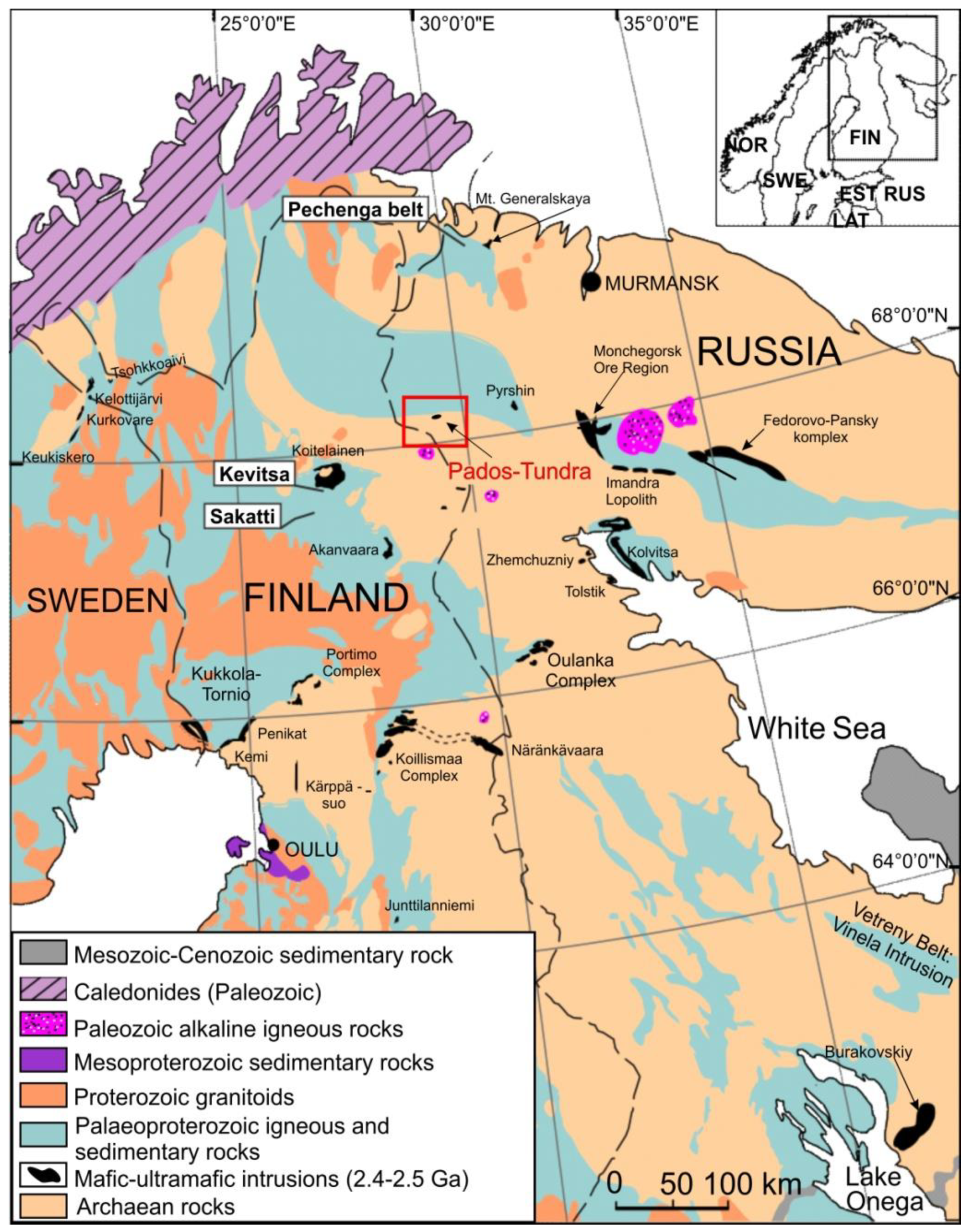
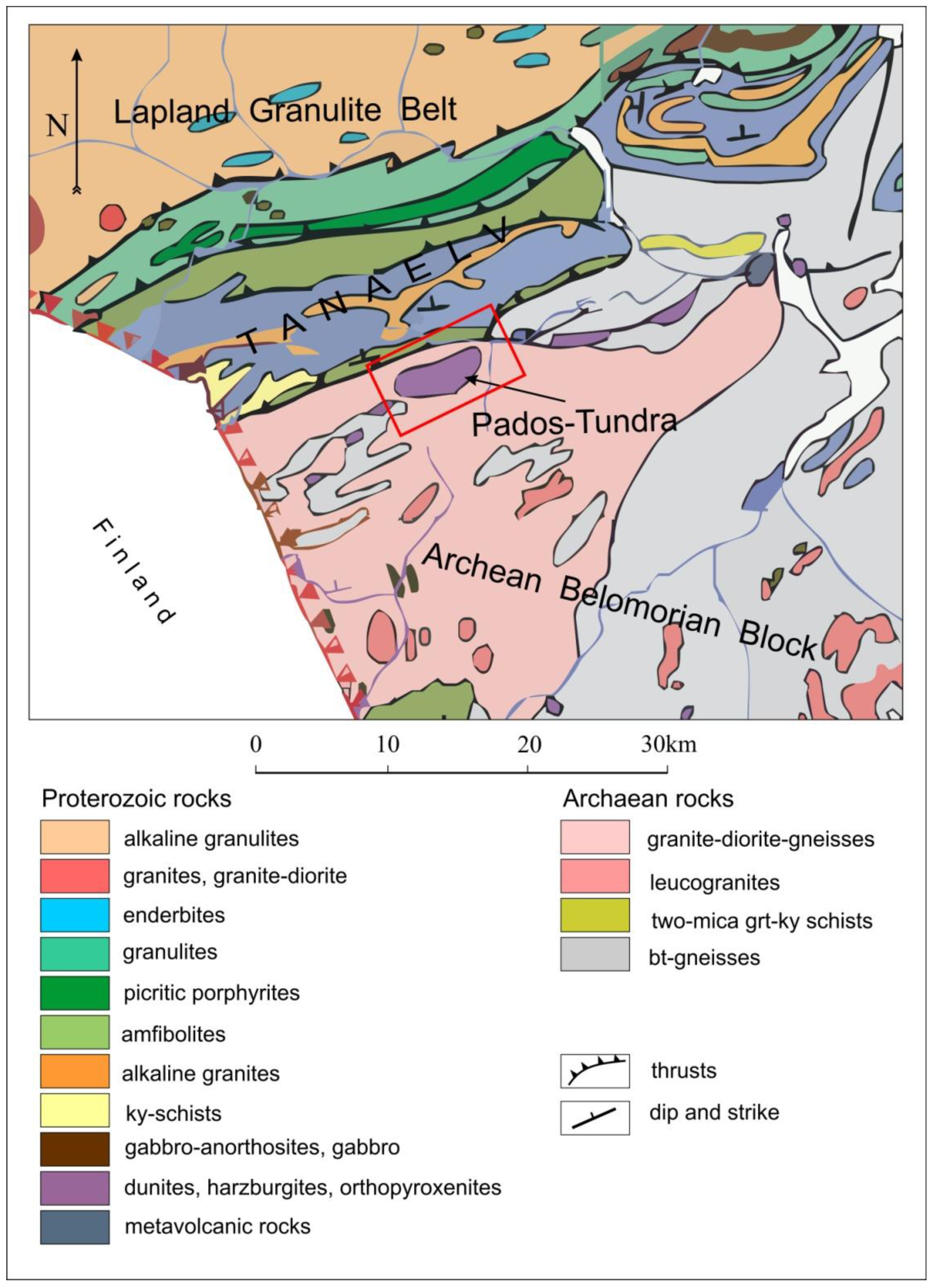
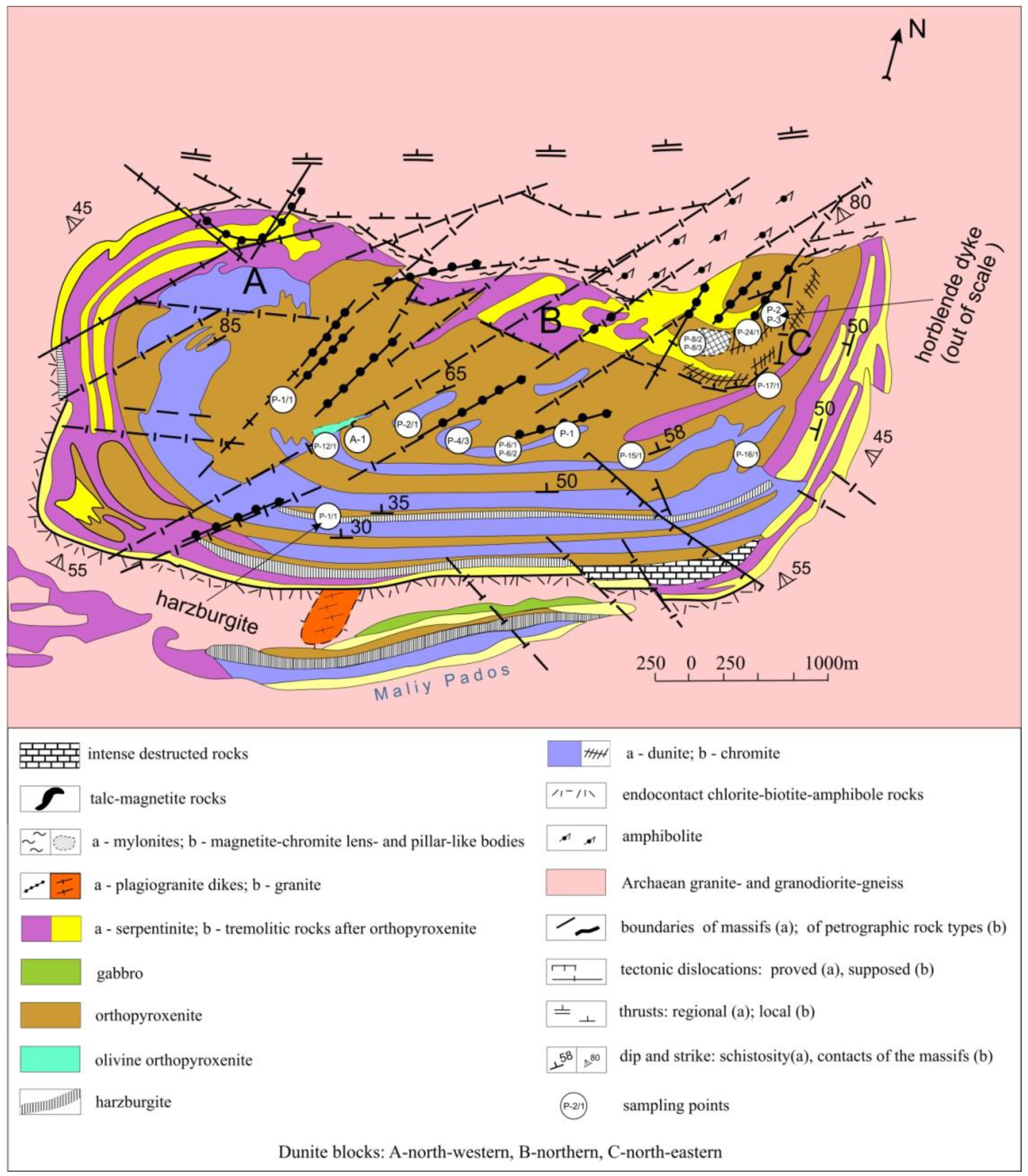

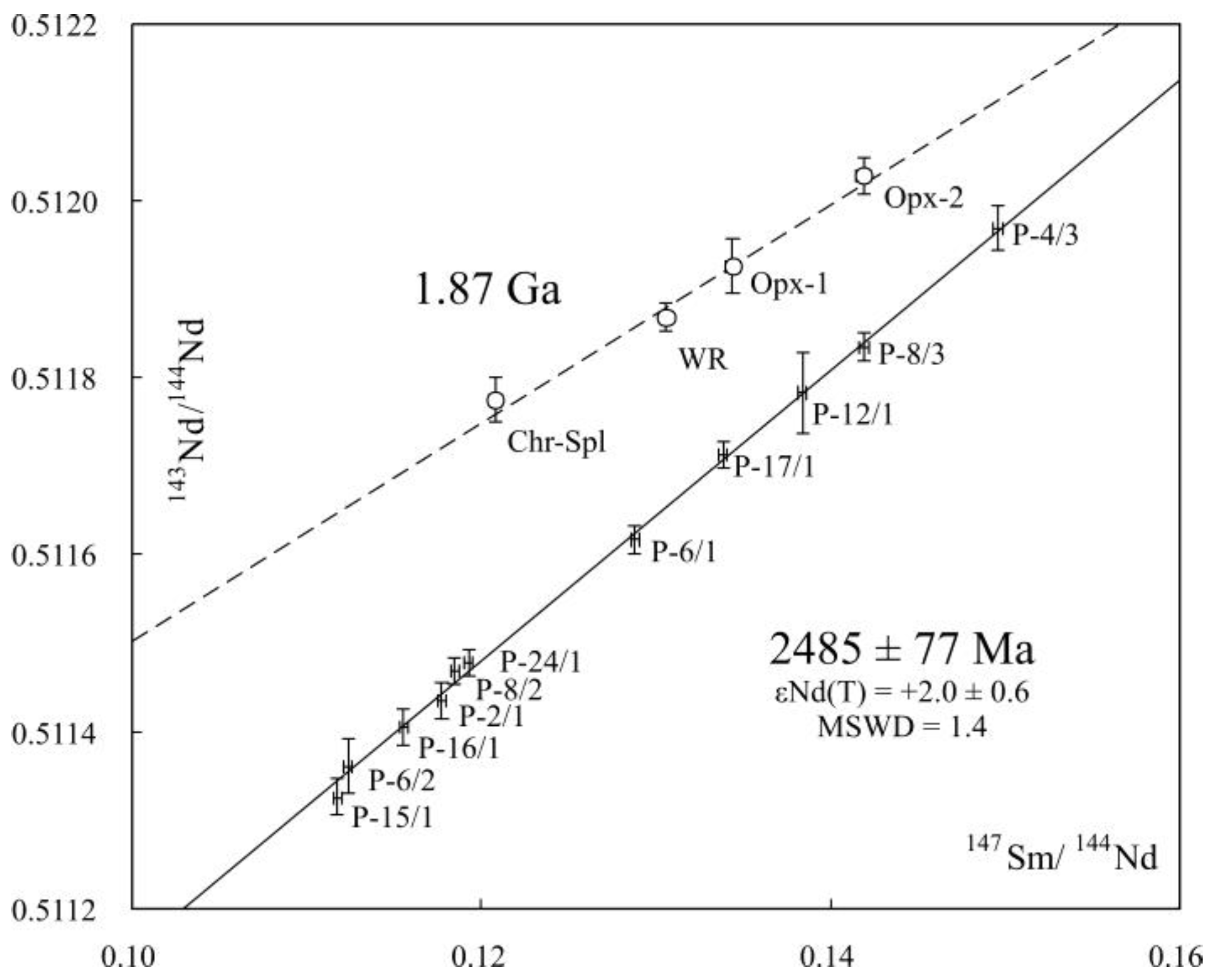
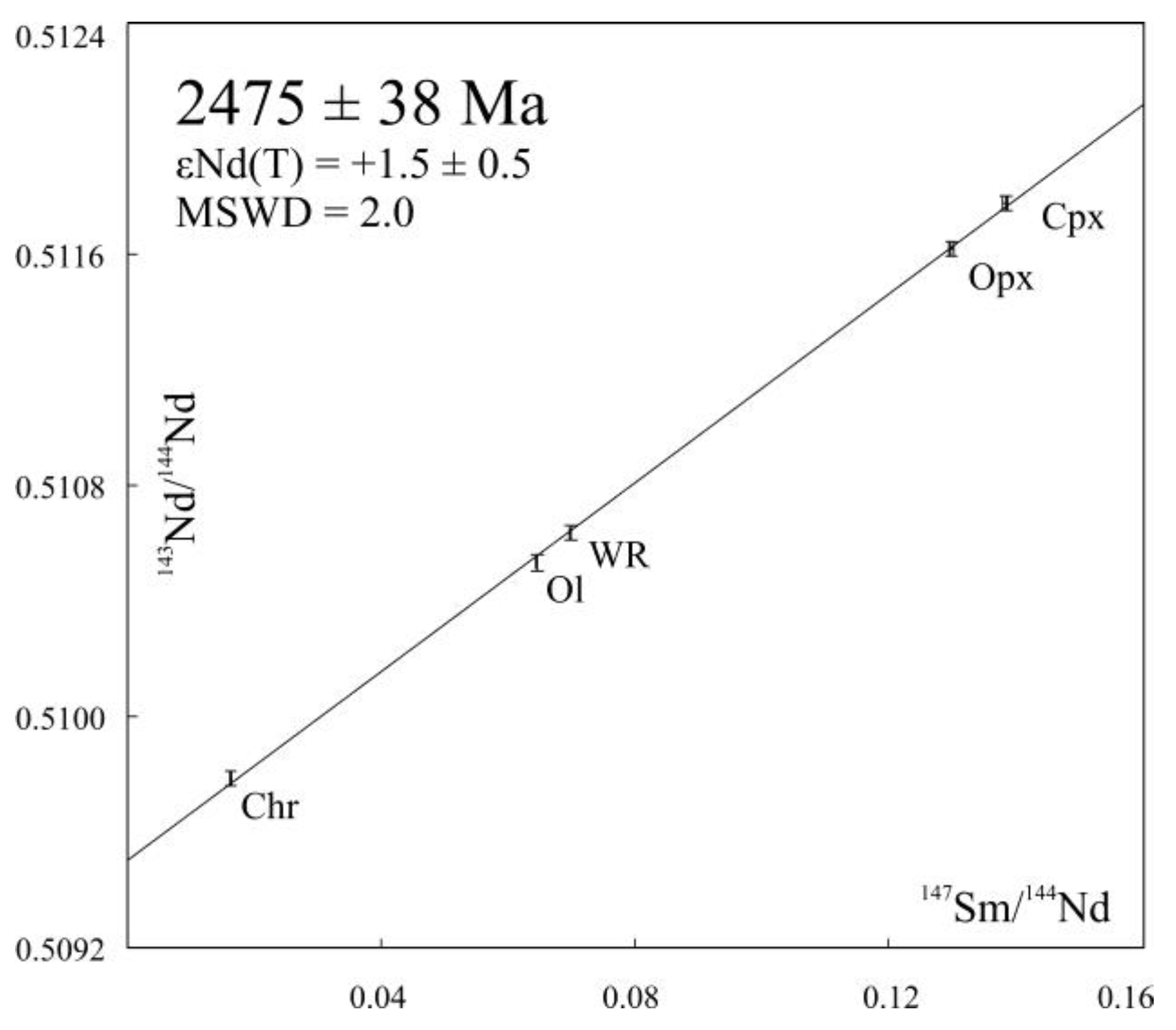

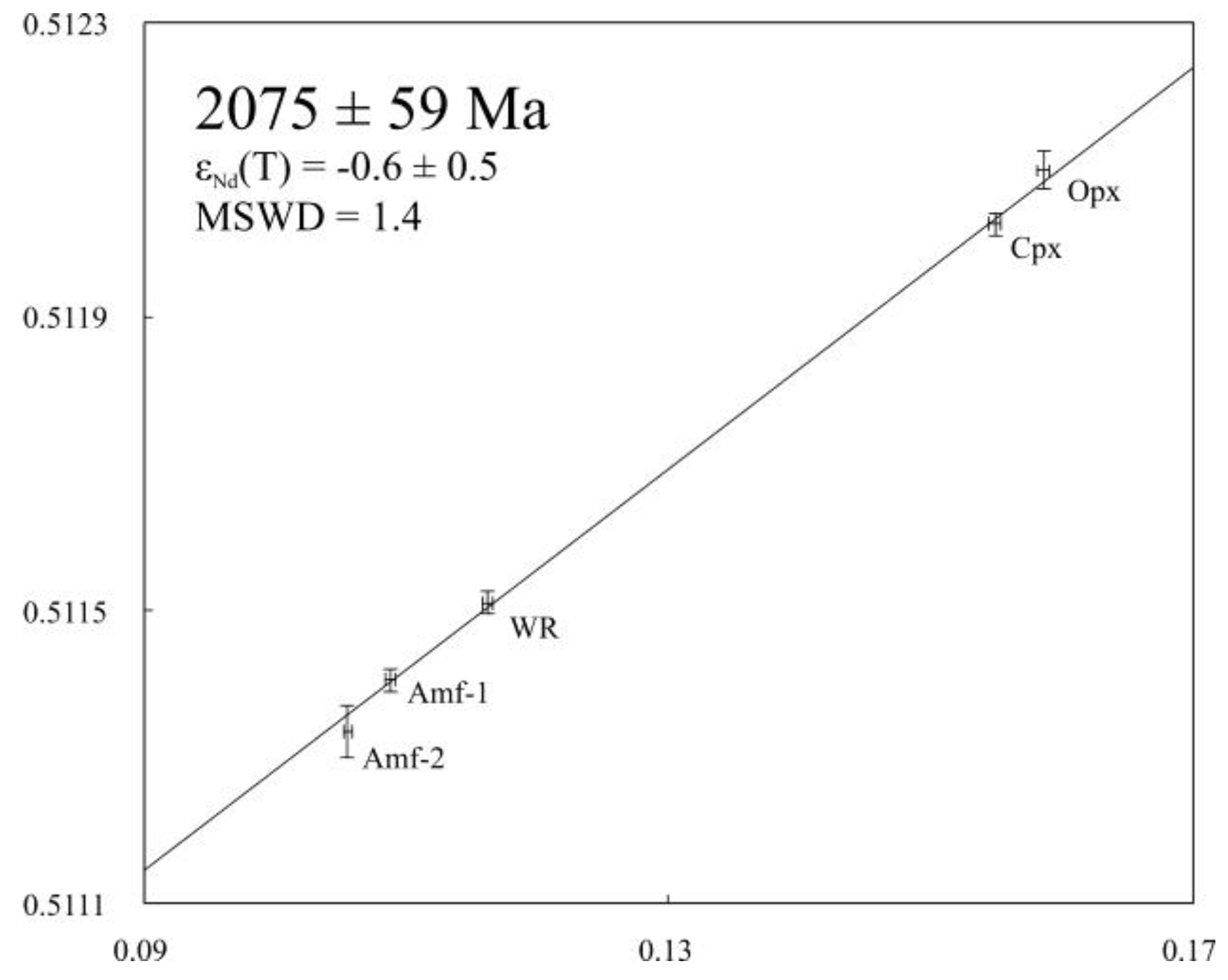
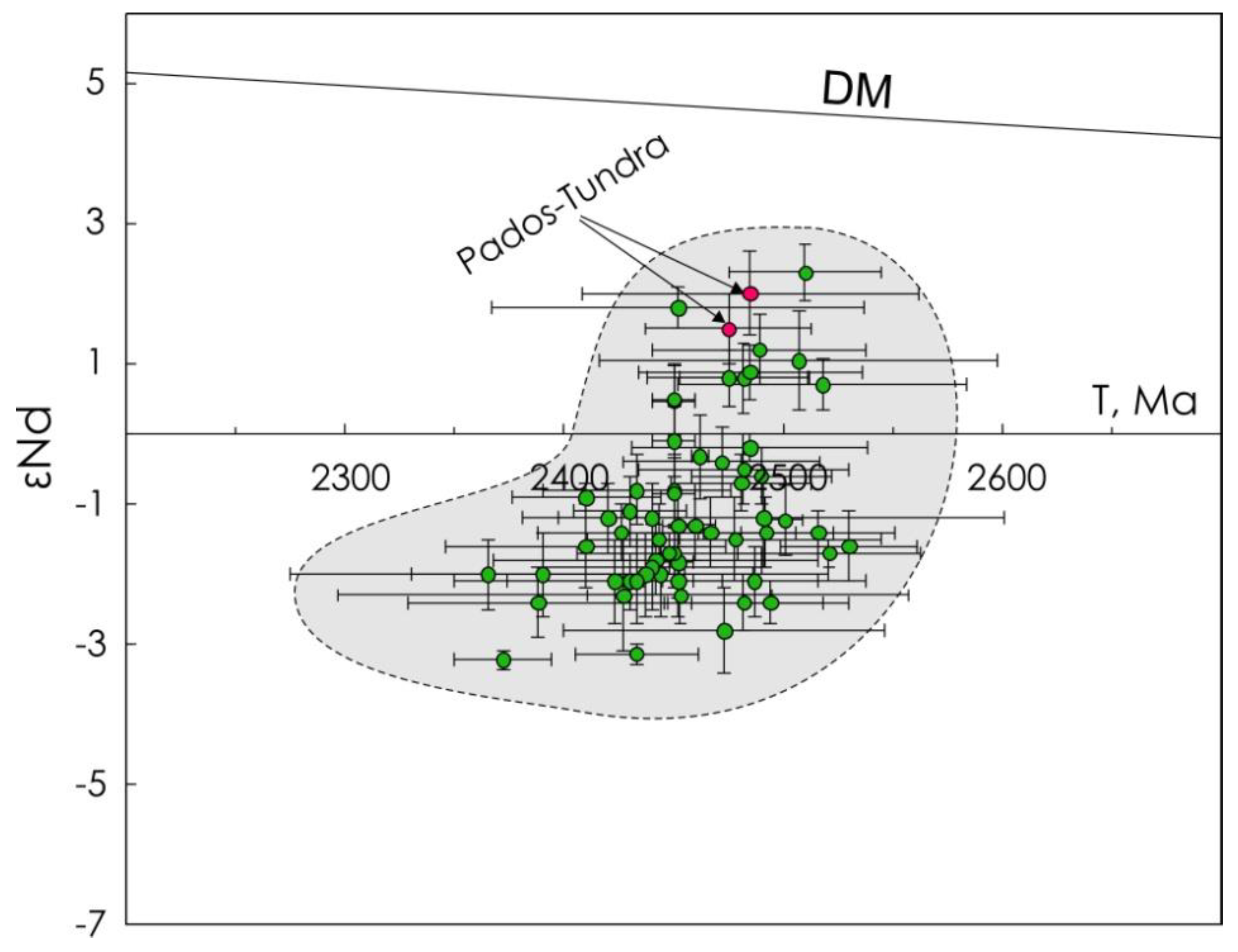
| Sample | Rock Type | Rhythm | Concentration, ppm | Isotope Ratios | TDM, Ma | εNd(T) | ||
|---|---|---|---|---|---|---|---|---|
| Sm | Nd | 147Sm/144Nd | 143Nd/144Nd | |||||
| P-15/1 | Serpentinized harzburgite | 5 | 0.068 | 0.346 | 0.1185 | 0.511469 ± 14 | 2681 | +2.3 |
| P-16/1 | Serpentinized olivinite | 5 | 0.013 | 0.064 | 0.1177 | 0.511436 ± 20 | 2712 | +1.9 |
| P-2/1 | Olivine pyroxenite (harzburgite) | 5 | 0.028 | 0.125 | 0.1338 | 0.511713 ± 11 | 2734 | +2.1 |
| P-4/3 | Pyroxenite | 6 | 0.037 | 0.157 | 0.1420 | 0.511835 ± 16 | 2784 | +1.9 |
| P-6/1 | Harzburgite | 5 | 0.024 | 0.106 | 0.1384 | 0.511783 ± 43 | 2757 | +2.0 |
| P-6/2 | Olivinite | 5 | 0.010 | 0.055 | 0.1155 | 0.511405 ± 22 | 2698 | +2.0 |
| P-12/1 | Pyroxenite | 6 | 0.017 | 0.091 | 0.1118 | 0.511326 ± 20 | 2717 | +1.6 |
| P-8/3 | Serpentinite (after dunite) | 7 | 0.028 | 0.130 | 0.1288 | 0.511617 ± 15 | 2742 | +1.9 |
| P-8/2 | Chromitite | 7 | 0.015 | 0.075 | 0.1193 | 0.511478 ± 15 | 2689 | +2.2 |
| P-17/1 | Serpentinized orthopyroxenite | 7 | 0.037 | 0.149 | 0.1496 | 0.511969 ± 42 | 2799 | +2.0 |
| P-24/1 | Olivinite | 7 | 0.021 | 0.115 | 0.1124 | 0.511361 ± 50 | 2681 | +2.1 |
| P-2 WR | Hornblendite (dyke) | 7 | 1.718 | 8.94 | 0.1162 | 0.511510 ± 10 | 2452 | -0.6 |
| P-2 Amf-1 | Amphibole | 1.201 | 6.67 | 0.1088 | 0.511405 ± 19 | |||
| P-2 Opx | Orthopyroxene | 0.400 | 1.525 | 0.1586 | 0.512099 ± 23 | |||
| P-2 Cpx | Clinopyroxene | 0.545 | 2.09 | 0.1549 | 0.512026 ± 15 | |||
| P-2 Amf-2 | Amphibole | 0.841 | 4.69 | 0.1055 | 0.511335 ± 35 | |||
| P-1/1 WR | Harzburgite | 3 | 0.014 | 0.119 | 0.0697 | 0.510636 ± 11 | 2650 | +1.3 |
| P-1/1 Ol | Olivine | 0.012 | 0.114 | 0.0644 | 0.510535 ± 18 | |||
| P-1/1 Cpx | Clinopyroxene | 0.036 | 0.159 | 0.1384 | 0.511777 ± 7 | |||
| P-1/1 Opx | Orthopyroxene | 0.038 | 0.176 | 0.1297 | 0.511620 ± 14 | |||
| P-1/1 Chr | Chromite | 0.012 | 0.444 | 0.0162 | 0.509786 ± 16 | |||
| A-1 WR * | Orthopyroxenite | 6 | 0.054 | 0.237 | 0.1306 | 0.511868 ± 17 | 2345 | +1.1 |
| A-1 Chr-Spl * | Chrome-spinellid | 0.017 | 0.083 | 0.1208 | 0.511775 ± 27 | |||
| A-1 Opx-1 * | Orthopyroxene | 0.097 | 0.435 | 0.1344 | 0.511926 ± 30 | |||
| A-1 Opx-2 * | Orthopyroxene | 0.055 | 0.233 | 0.1419 | 0.512028 ± 20 | |||
| No | Weight, mg | Concentrationppm | Pb Isotope Ratios | Isotope Ratios and Age, Ma | Rho | |||||
|---|---|---|---|---|---|---|---|---|---|---|
| Pb | U | 206Pb/204Pb | 206Pb/207Pb | 206Pb/208Pb | 207Pb/235U | 206Pb/238U | 207Pb/206Pb | |||
| 1 | 0.90 | 34.2 | 68.5 | 1262 | 6.8482 | 2.7865 | 6.69040 | 0.377083 | 2080 | 0.85 |
| 2 | 0.70 | 44.8 | 90.5 | 834 | 6.8542 | 2.7265 | 6.62931 | 0.372992 | 2089 | 0.95 |
| 3 | 0.70 | 34.2 | 77.4 | 762 | 6.8482 | 2.7865 | 5.91776 | 0.333536 | 2080 | 0.83 |
| 4 | 0.80 | 2.79 | 6.3 | 20 | 1.2556 | 0.5130 | 4.88857 | 0.321434 | 1804 | 0.51 |
© 2020 by the authors. Licensee MDPI, Basel, Switzerland. This article is an open access article distributed under the terms and conditions of the Creative Commons Attribution (CC BY) license (http://creativecommons.org/licenses/by/4.0/).
Share and Cite
Serov, P.A.; Bayanova, T.B.; Steshenko, E.N.; Kunakkuzin, E.L.; Borisenko, E.S. Metallogenic Setting and Evolution of the Pados-Tundra Cr-Bearing Ultramafic Complex, Kola Peninsula: Evidence from Sm–Nd and U–Pb Isotopes. Minerals 2020, 10, 186. https://doi.org/10.3390/min10020186
Serov PA, Bayanova TB, Steshenko EN, Kunakkuzin EL, Borisenko ES. Metallogenic Setting and Evolution of the Pados-Tundra Cr-Bearing Ultramafic Complex, Kola Peninsula: Evidence from Sm–Nd and U–Pb Isotopes. Minerals. 2020; 10(2):186. https://doi.org/10.3390/min10020186
Chicago/Turabian StyleSerov, Pavel A., Tamara B. Bayanova, Ekaterina N. Steshenko, Evgeniy L. Kunakkuzin, and Elena S. Borisenko. 2020. "Metallogenic Setting and Evolution of the Pados-Tundra Cr-Bearing Ultramafic Complex, Kola Peninsula: Evidence from Sm–Nd and U–Pb Isotopes" Minerals 10, no. 2: 186. https://doi.org/10.3390/min10020186
APA StyleSerov, P. A., Bayanova, T. B., Steshenko, E. N., Kunakkuzin, E. L., & Borisenko, E. S. (2020). Metallogenic Setting and Evolution of the Pados-Tundra Cr-Bearing Ultramafic Complex, Kola Peninsula: Evidence from Sm–Nd and U–Pb Isotopes. Minerals, 10(2), 186. https://doi.org/10.3390/min10020186




